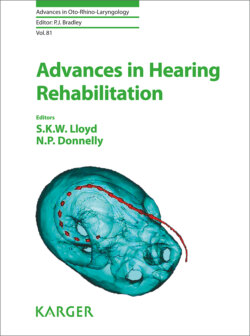Читать книгу Advances in Hearing Rehabilitation - Группа авторов - Страница 48
На сайте Литреса книга снята с продажи.
Direct-Drive Devices
ОглавлениеCochlear Bone Anchored Solutions’ current designs comprise of BAHA 5, BAHA 3 Power and Cordelle II. The BAHA 5 audiological fitting range can compensate for an average of 45 dB bone conduction thresholds across 0.5, 1, 2 and 3 kHz. In comparison, the BAHA 3 Power thresholds can be up to 55 dB. The Cordelle II, which uses a body-worn sound processor, is appropriate for thresholds up to 65 dB over the same frequency range. A single-blinded study, comparing the BAHA 5 to previous generations of processors, found that 9 out of 10 patients rated speech understanding and sound quality good, with 7 out of 10 choosing the latest processor over its predecessors. This shows that improvements in device design are producing noticeable patient benefits [6]. Additionally, a postal questionnaire completed by 227 patients from the Birmingham BCHI program, found that 79.3% of respondents preferred BCHIs over conventional hearing aids or Softband in quiet, and 59.2% in noise [7].
Oticon Medicals’ percutaneous bone conduction hearing systems are the Ponto Plus and Ponto Plus Power. Recommended audiological fitting ranges for the Ponto Plus and Ponto Plus Power are that pure conductive and mixed hearing losses do not exceed an average bone conduction threshold of over 45 and 55 dB, respectively. A small study of 12 patients by Olsen et al. [8] compared user preferences between the BP100 BAHA and the Ponto Pro. Both devices have now been upgraded by their respective manufacturers and thus the study’s conclusions may no longer be valid. However, the Ponto Pro speech intelligibility was rated higher than the BP100, with 8 of 12 subjects preferring the Ponto Pro overall.
The Bonebridge (Vibrant MED-EL, Innsbruck, Australia) consists of an external sound processor and an internal bone conduction implant (BCI). The BCI has been conditionally certified for magnetic resonance imaging up to 1.5 Tesla and is approved for use in children 5 years or older. The sound processor is worn externally and attached via a variable strength magnet to the patient’s head. The BCI includes a floating mass transducer that produces mechanical vibrations transferred to the mastoid bone via 2 cortical screws. Combining audiological results from 45 patients in 4 different studies, there was a mean 29.4 dB gain in aided versus unaided pure tone audiogram results [9–12]. Ihler et al.’s [12] study of 6 patients found that there was a mean improvement of 36.1 in the Glasgow benefit inventory (GBI) postoperatively.
